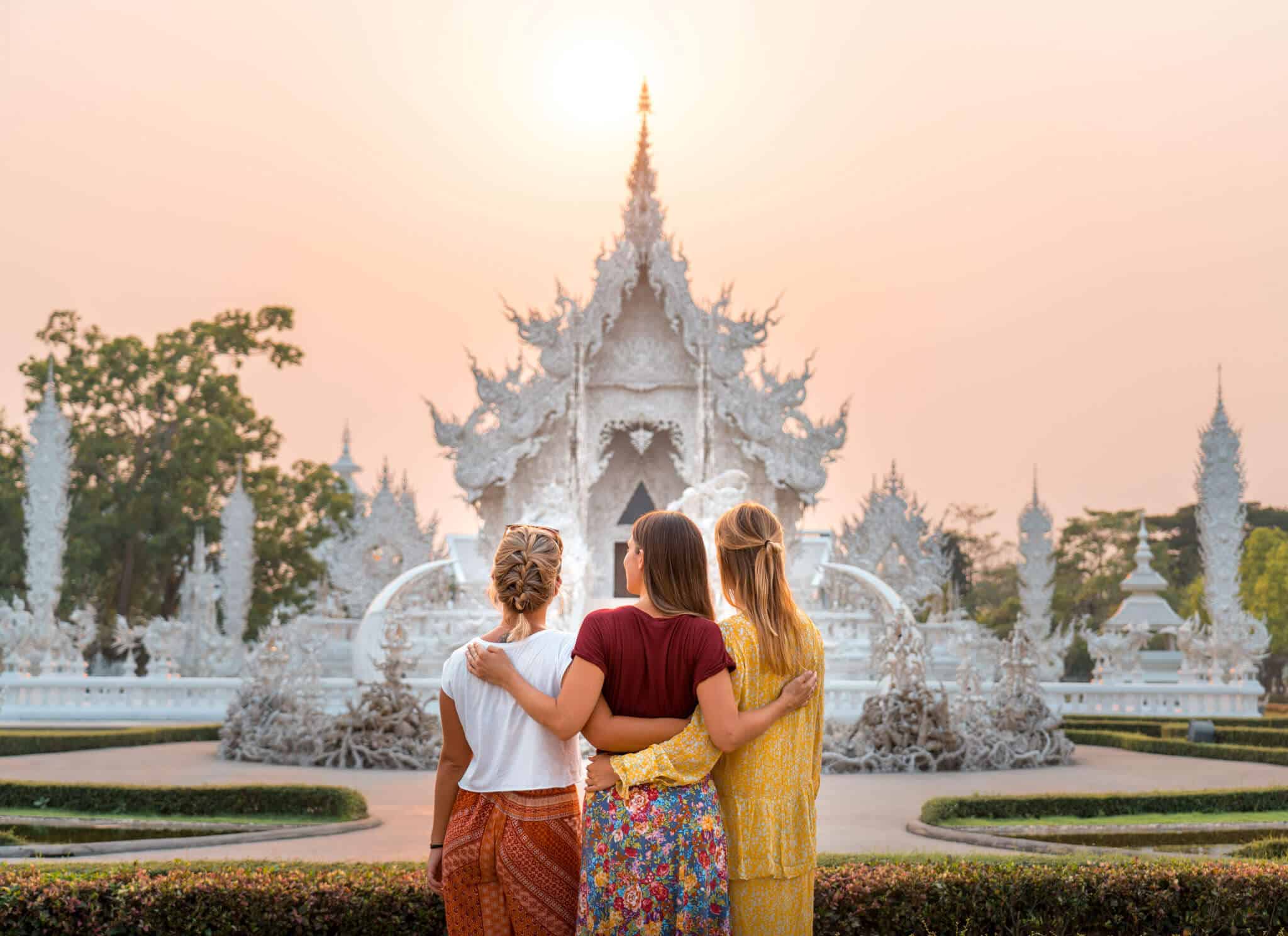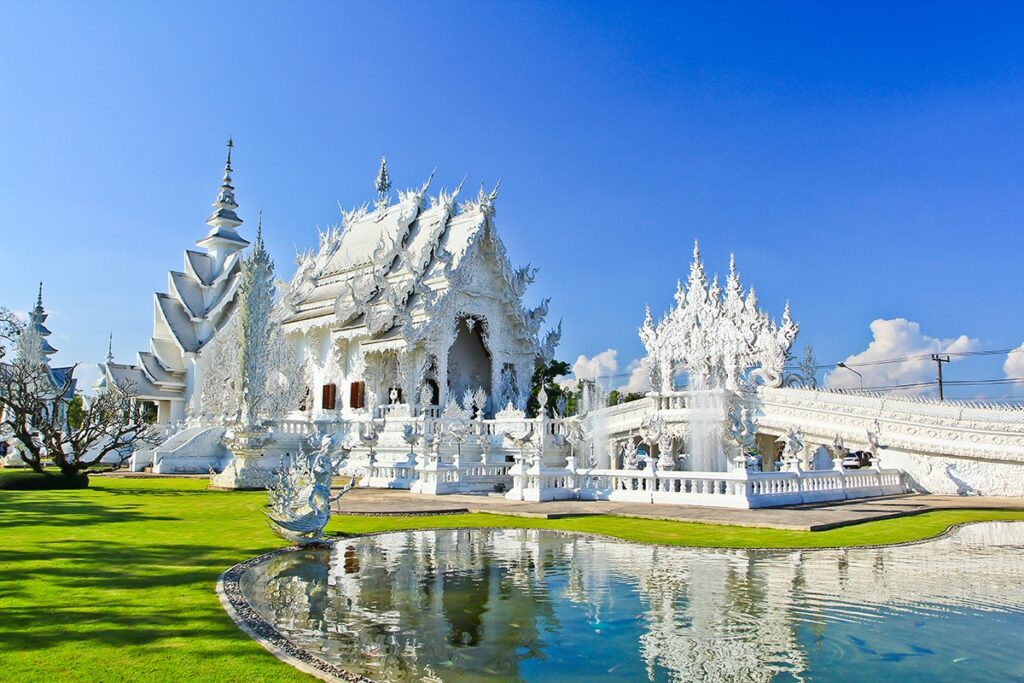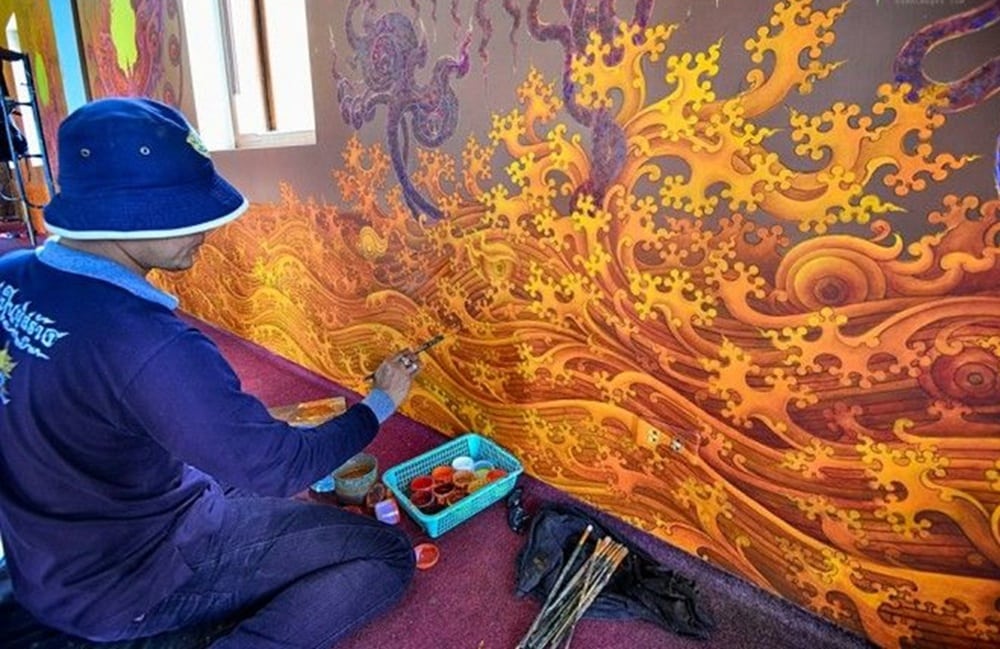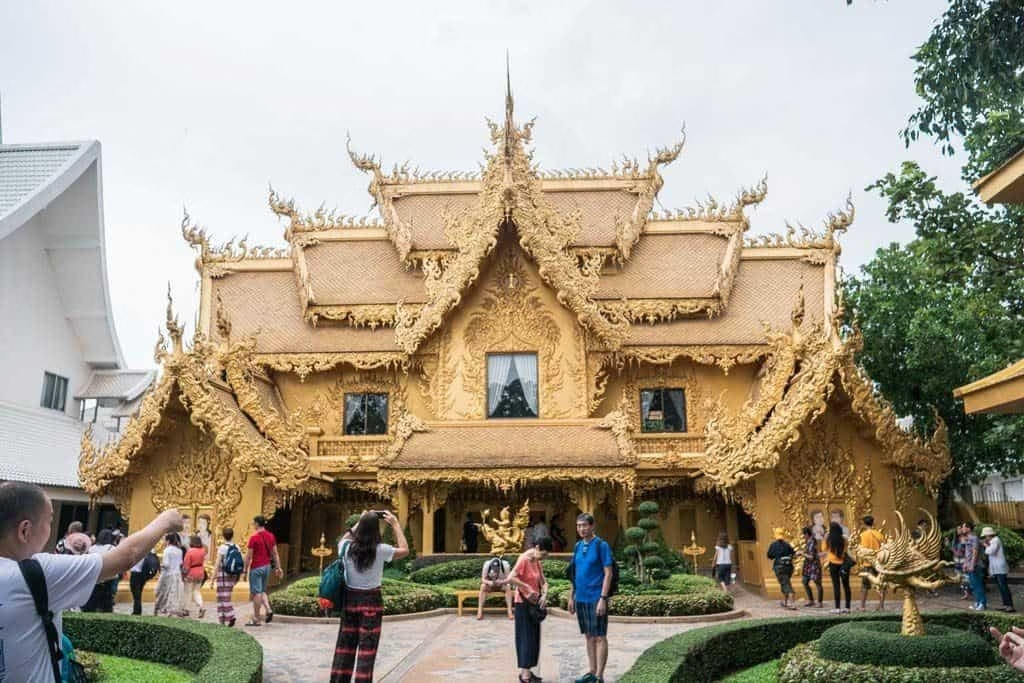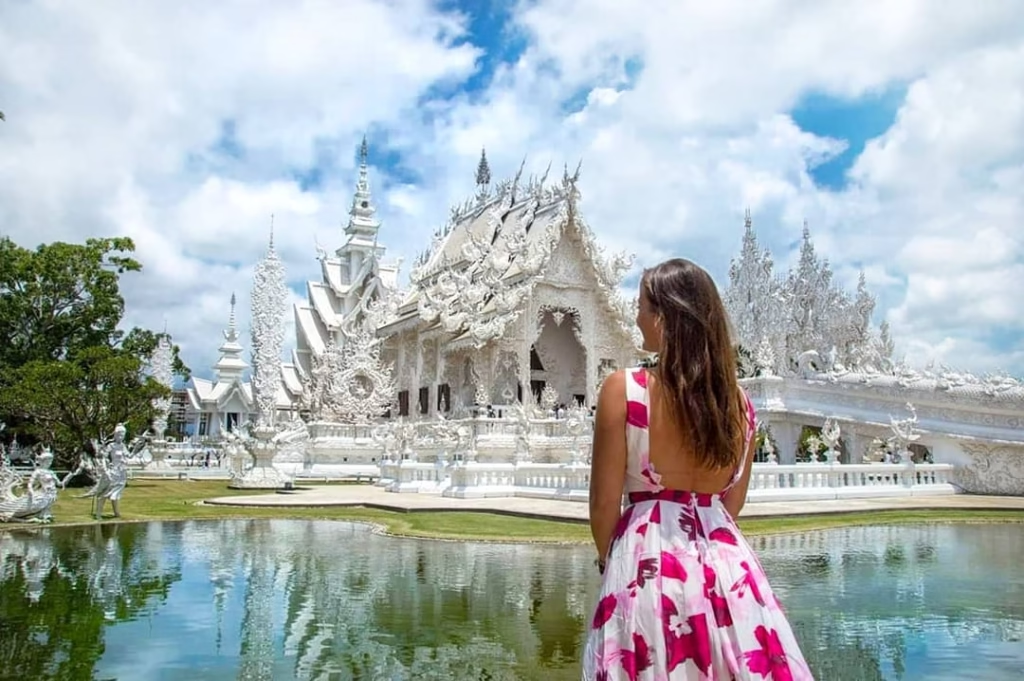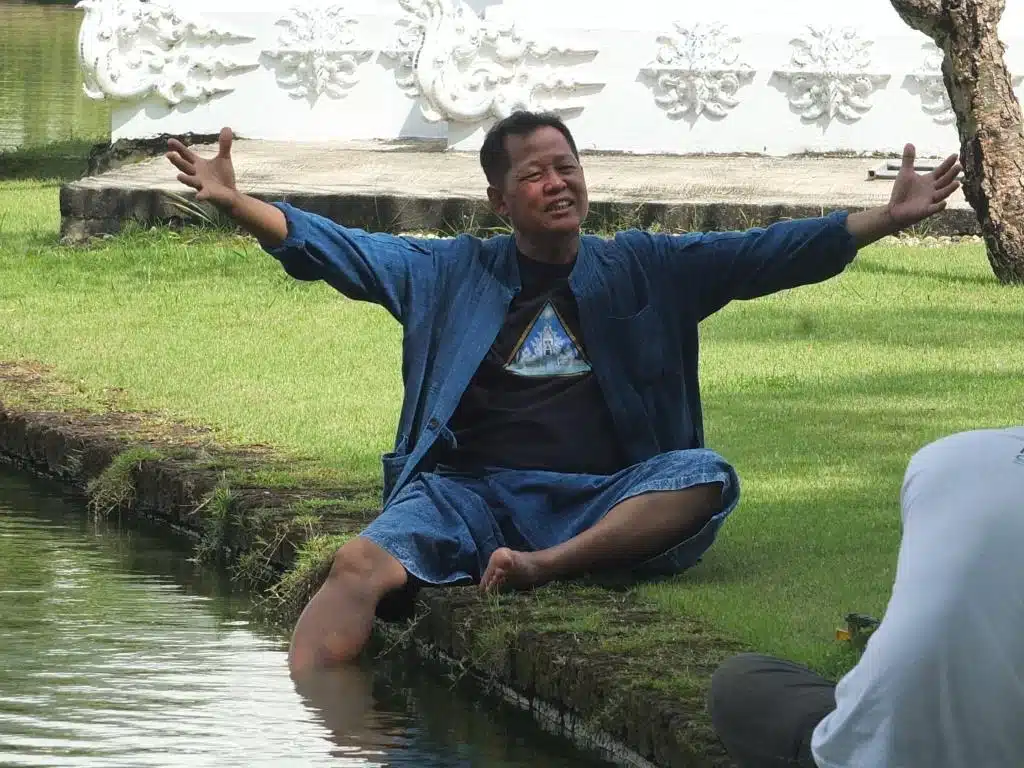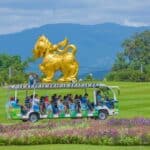CHIANG RAI – Most Thai temples welcome visitors with worn gold leaf, smoke-stained ceilings, and the soft weight of history. Wat Rong Khun does the opposite. It hits the eyes like a flash. Under the northern Thai sun, the temple glows in fierce, icy white, shining like a shard of frozen lightning against the green rice fields of Chiang Rai.
Locals still call it Wat Rong Khun, but travellers everywhere know it as the White Temple, a surreal, almost unreal vision that looks less like a quiet monastery and more like a movie set from a strange dream.
The mind behind this vision is Chalermchai Kositpipat, a painter who rose to national fame. In 1997, he returned to his childhood temple and found it in ruins, the roof leaking, the structure failing. He decided to rebuild it with his own money and on his own terms, ignoring many rules that guide traditional temple design.
The Crumbling Temple That Sparked a Vision
The first Wat Rong Khun dates back to the late 19th century. It was a small, modest temple in the Lanna style, and over time, it simply fell apart. After the Second World War, the building received little care. By the 1970s, the ubosot (ordination hall) had become unsafe. Many villagers chose newer temples closer to the town centre instead.
When Chalermchai, by then a rising name in Bangkok’s contemporary art circle, returned to Chiang Rai in the mid-1990s, the sight of his childhood temple shocked him.
He later told reporters, “I cried when I saw it. The Buddha image was broken, the murals were eaten by termites. I felt it was my duty, my fate, to bring it back.”
He offered to restore the temple free of charge. The abbot hesitated at first and worried about the artist’s bold style and reputation. That did not stop Chalermchai. In 1996, he bought the land around the ruined complex and began the project that would define his life.
A Temple That Breaks the Rules on Purpose
Anyone who crosses the bridge to the main ubosot today sees at once that this is no ordinary Thai wat. Beneath the walkway, hundreds of sculpted hands reach up out of a pit. Some beg, some claw, some form crude gestures.
They stand for uncontrolled desire and the endless loop of suffering known as samsara. Demonic faces twist from the railings, teeth bared. It feels like a meeting between Dante’s Inferno and Buddhist teaching, all set in dazzling plaster inlaid with mirror fragments.
His choice of pure white is no accident. Traditional Thai temples glow in gold, which reflects the purity of the Buddha, or burst with bright colours that express joy and community. In Thai culture, white often relates to mourning and death. Chalermchai turns that meaning around.
“White shows the purity of Lord Buddha’s mind,” he explains. “Gold belongs to worldly kings. This temple belongs to heaven.”
Almost every surface is covered in tiny mirrors that catch the sun and scatter it in sharp flashes. The artist calls these fragments “wisdom that reflects and teaches”.
Funding the Dream with Paintings and Small Gifts
The story of how Wat Rong Khun is financed is almost as striking as its appearance. Chalermchai refuses any single donation larger than 10,000 baht (about 300 US dollars).
His reasoning is simple. “If I take millions from a rich man, he will think he owns the temple and will tell me what to build,” he says. “This is my artwork. It must stay clean.”
Instead, the temple grows through a mix of the artist’s own income and thousands of small acts of support. He sells his paintings and limited-edition prints, some for as much as 50,000 US dollars each. Foreign visitors pay an entrance fee, while Thai people enter free of charge. Visitors drop coins and notes into clear acrylic boxes shaped like tiny White Temples.
By 2025, the total cost of construction had passed 1.2 billion baht, roughly 40 million US dollars, and the spending has not stopped.
Just as the first sharp white spires began to rise, the Asian Financial Crisis of 1997 hit Thailand hard. Work stopped. Wages went unpaid. Creditors called. Chalermchai fell into a deep depression and spent long days on the half-built bridge, smoking and staring at the stalled site.
In a move that locals still talk about, he sold almost his entire personal art collection in Europe and America. He returned to Thailand with the money in suitcases, paid his workers, cleared the worst of his debts, and brought the project back to life within weeks.
He later said, “I told my team, if we stop now, the temple will stand half finished forever, like a broken tooth. I would rather die than let that happen.”
Pop Culture Images Inside a Sacred Space
Inside the ubosot, where visitors must keep cameras away, the walls shock many first-time guests. Instead of classic scenes from the Jataka tales in red and gold, the murals show modern icons and dark global events.
Neo from The Matrix fires a gun. Michael Jackson dances near a nuclear mushroom cloud. Superman flies in the same frame as an ancient Buddha image. A monstrous George W. Bush and Osama bin Laden ride the same missile through the sky.
Critics sometimes complain, but Chalermchai stands firm. “Buddhism must speak to people today,” he says. “Young people do not care about scenes painted 500 years ago in red and gold. They know Keanu Reeves. I use what they recognise to talk about good and evil, mindfulness, and the danger of technology without wisdom.”
These bold murals suffered heavy damage in the Chiang Rai earthquake of 2014, which measured 6.3 in magnitude. Cracks tore through the ubosot walls, and several guardian sculptures collapsed. At 59, the artist cried on national television and declared that the temple had died.
Less than a day later, he changed course. Using the insurance payout, along with fresh income from his art, he promised to rebuild Wat Rong Khun stronger, whiter, and even more complex. Work crews were back on site before the aftershocks had fully stopped.
A Living Project That May Never Finish
Nearly three decades after the first foundation was laid, Wat Rong Khun still counts as unfinished, and Chalermchai insists that it will stay that way. His original master plan lists nine major buildings, including the ubosot, a golden toilet complex, a crematorium, a meditation hall, and a gallery for his art. At present, only four of these are complete.
He once joked, “Even going to the toilet should have beauty,” as visitors admire the bright gold restroom block that looks more like a small palace than a public facility.
Now in his seventies, he spends part of his time teaching dozens of apprentices in a studio on the temple grounds. He shows them how to carve plaster in delicate patterns and how to set mirror tiles by hand.
He estimates the temple will need another 60 to 70 years and may be finished around 2090, if it is ever called complete at all. “When I die, my students will continue,” he says. “This is not my temple. It belongs to the future.”
Beyond Crowds and Selfie Sticks of White Temple
Wat Rong Khun has become a social media favourite, and the numbers prove it. More than two million visitors arrive each year. Tour buses line the road. Teenagers pose on the Bridge of the Cycle of Rebirth while friends snap photos from every angle. Stalls nearby sell miniature replicas, postcards, and T-shirts printed with the White Temple.
Those who walk away from the main route find quieter spaces. Beyond the famous golden toilets (which really are worth a stop), there is a wishing well in the shape of a meditating monk. A small grove of metal trees holds hundreds of hanging prayer tags, each one scratched with names and short hopes. In a simple hermitage on the grounds, Chalermchai sometimes retreats to paint in silence.
Residents still visit to make merit. Monks still chant. Beneath the pop culture images and the crowds, the core message of Buddhism stays the same: release desire, live with awareness, and escape the grasping hands of suffering.
The Legacy of One Man’s Obsession
Chalermchai Kositpipat could have stepped back years ago. He was already rich, famous, and honoured by the Thai king with the title of National Artist. Instead, he poured his fortune, time, and energy into a snow-white dream in the rice fields where he grew up.
He has no children of his own. Wat Rong Khun is his child, his protest, and his devotion to the Buddha and to Thailand.
Stand on the mirrored bridge at sunset, when the sky turns purple and the temple burns in white light, and the meaning of his work becomes clear. This is what happens when one person refuses to accept decay. When pride and faith collide at full speed. When an artist decides that heaven should look exactly like the picture in his mind.
The White Temple is many things at once: a tourist draw, an architectural wonder, a fierce Buddhist sermon, and a bold challenge to tradition. Above all, it shows how far obsession, guided with focus and faith, can shape the world.




